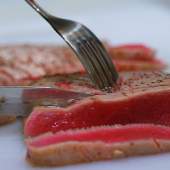Potatoes

September means many things to many people. Here at The World of Food, we’re enjoying National Potato Month, a great time to celebrate one of the world’s perfect foods: easy and inexpensive to cultivate (far more so than many other subsistence crops), and chock-full of almost every nutrient needed for survival — especially potassium and vitamin C. Also, a delicious stomach-filler, adaptable to a wide variety of purposes.
As outlined in our treatise on Peru, it was the Spanish conquistadors who, having conquered the country where the potato originated, brought it back with them to Spain in the 1500s. By the end of that century, it had spread to other countries, notably Ireland, where it caught on big time.
Potatoes weren’t always so popular. That they became so is largely due to one significant historical figure: Antoine-Augustin Parmentier, a French physician and pharmacist who lived from 1737 to 1813. Prior to his arrival at the French court of Louis XVI and Marie “let them eat cake” Antoinette, outside of Ireland and Spain the potato was considered only marginally edible (there was a time when it was even thought to cause leprosy) and suitable only for animal feed.
Parmentier, however, had spent some time in a Prussian prison during the Seven Years’ War, and had done remarkably well on a potatoes-only diet. He proved to be a promotional genius for les pommes de terre, touting them as a nutritious replacement for flour, devising the first recipe for potato bread, bestowing potato blossoms on the King and Queen, stationing guards around his potato plot to inflate their perceived value, and hosting lavish dinners for the elite composed entirely of potato dishes — singing their praises to such luminaries as Benjamin Frankin (then the U.S. ambassador to France), who undoubtedly shared the news with Thomas Jefferson, our “epicurean president” (to whom we owe the introduction of French fries). Movingly, Parmentier’s Paris cemetery plot is ringed with potato plants.
Antoine-Augustin Parmentier
As time moved on, Ireland in particular embraced the almighty potato, because so much of its land area was taken up for grazing (due to the heavy demand for beef), and potatoes required very small plots in which to grow. Potatoes became a vital part of every meal — it is said that at one point, an average working man was consuming 10 pounds of potatoes daily, and for two out of five Irish citizens, potatoes composed the entirety of their diet. So it’s not hard to see why, when the Great Potato Famine hit the Emerald Isle in the 1840s, it was a tragedy of truly epic proportions — at its height, the (thankfully now believed to be extinct) Potato Blight decimated almost three-quarters of the crop, leading to the deaths of upwards of a million people from either starvation or disease. This changed the course of history, as shortly after, Ireland experienced a dramatic drop in population when a quarter of its people immigrated to other places, mostly North America, in search of a reliable source of food. Ireland’s numbers have yet to fully recover today…all because of the humble potato.
How did the potato reach the United States, and when? It seems that the governor of Bermuda, Nathaniel Butler, and the governor of Virginia, Francis Wyatt, were acquaintances, and in 1621 (14 years after the establishment of the Jamestown settlement), Butler shipped two cedar chests of vegetables, including potatoes, to his Virginia counterpart. It took almost a century for potatoes to become a bumper crop in the American colonies (perhaps Governor Wyatt hoarded them for himself!), but the first town to sign on was Londonderry (now Derry), New Hampshire, and they spread from there. Idaho, the U.S. state best known for potatoes, came to the party late, in 1836; rumor has it that some vegetarian missionaries encouraged potato growth as an alternative to slaughtering animals for sustenance. Idaho’s potato industry didn’t explode until 1872.
Today, there are more than 200 varieties of potatoes grown in the United States, across seven different categories: russet, red, white, yellow, blue/purple, fingerling, and petite. The vast majority of them are used in the production of frozen French fries (of course — you can’t think of a burger without them). Or there’s potato-leek soup, or potato pancakes, or shepherd’s pie topped with mashed potatoes.
What about potato chips? Potato Goodness shares this story: “In 1853, railroad magnate Commodore Cornelius Vanderbilt complained that his potatoes were cut too thick and sent them back to the kitchen at a fashionable resort in Saratoga Springs, New York. To spite his haughty guest, Chef George Crum sliced some potatoes paper-thin, fried them in hot oil, salted and served them. To his surprise, Vanderbilt loved his ‘Saratoga Crunch Chips,’ and potato chips have been popular ever since.”
Bringing this back to the beginning, the Peruvian Incas had a variety of uses for potatoes (again courtesy of Potato Goodness), some with questionable efficacy. Some of these might be worth trying:
- placing raw slices on broken bones to promote healing
- carrying them to prevent rheumatism
- consuming them with other foods to prevent indigestion
- measuring time, by how long it took for potatoes to cook
- treating facial blemishes by washing with cool potato juice
- alleviating frostbite or sunburn by applying raw grated potato or potato juice to the affected area
- soothing a toothache by carrying a potato in a pocket
- easing a sore throat by tying a slice of baked potato in a stocking around the neck
- treating aches and pains by rubbing the affected area with the water potatoes have been boiled in
There’s even a woodwind instrument (the ocarina), known as a “sweet potato,” which Bing Crosby, Bob Hope, and Dorothy Lamour famously played (“Sweet Potato Piper”) in The Road to Singapore.
So… there are plenty of uses for potatoes, but above all, eat them! Monsieur Parmentier would insist, n'est-ce pas?





